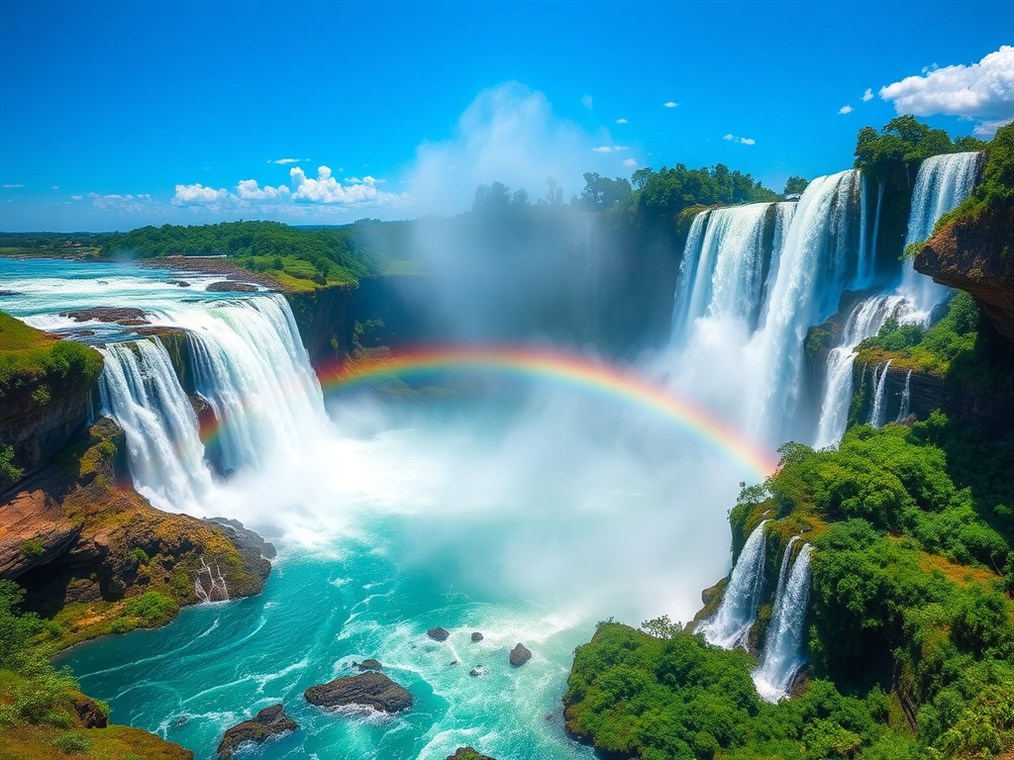
Niagara Falls vs. Iguazu Falls: Which Waterfall Truly Wows?
FactsNiagara Falls vs. Iguazu Falls: Which Waterfall Truly Wows?
Okay, picture this: you’re standing in front of a waterfall so massive, so breathtaking, it feels like nature’s giving you a high-five. Now, imagine comparing two of these giants: Niagara Falls and Iguazu Falls. Both are bucket-list destinations, drawing gasps and clicks from millions. But which one’s actually “bigger”? Well, that’s not as simple as it sounds. It’s like asking if an elephant is “bigger” than a blue whale – depends on what you mean! Let’s dive in and see which of these watery titans truly reigns supreme.
First up: the raw stats. Niagara, straddling the US and Canada, is actually a trio of falls: Horseshoe (the big kahuna), American, and Bridal Veil. Horseshoe, the star of the show, drops a respectable 188 feet, with a crest stretching over 2,200 feet. The American Falls isn’t quite as tall, clocking in between 70 and 110 feet, but still impressive at over 1,000 feet wide. Altogether, you’re looking at nearly 4,000 feet of watery wonder.
Now, Iguazu… Iguazu is a whole different beast. Instead of a few distinct falls, it’s more like a watery explosion, a chaotic collection of around 275 individual cascades. Picture this sprawling out over nearly two miles! These falls vary in height, ranging from around 200 to almost 270 feet. And the crown jewel? The Devil’s Throat – a U-shaped monster that’s taller than Niagara, wider than a football field, and just plain awe-inspiring.
So, right off the bat, Iguazu wins on sheer scale. It’s wider, it’s got more individual falls, it’s just… bigger.
But hold on a second, let’s talk about water. Niagara is a powerhouse, churning out an average of 85,000 cubic feet of water every second. That’s like emptying a small lake over the edge every minute! And during peak season? Forget about it – we’re talking over 168,000 cubic meters of water roaring over the edge. Of course, they do throttle it back a bit for power generation, especially at night.
Iguazu, on the other hand, averages around 62,000 cubic feet per second. But get this: it can spike like crazy. Back in 2014, they recorded a mind-boggling 1,614,000 cubic feet per second! That’s enough to fill an Olympic swimming pool in the blink of an eye.
The verdict here? Niagara is more consistent, a reliable river of awesome. But Iguazu? Iguazu has the potential to unleash a truly biblical flood.
And what about height? Well, Iguazu’s Devil’s Throat is a bit taller than Niagara’s Horseshoe Falls. So, another point to Iguazu!
But here’s the thing: numbers don’t tell the whole story. Niagara is a spectacle, no doubt about it. It’s easily accessible, the sheer force of the water is mind-blowing, and there are tons of things to do – from getting soaked on the Maid of the Mist to gazing down from observation towers. It’s a well-oiled tourism machine.
Iguazu, though? Iguazu is an experience. It’s raw, it’s wild, it’s surrounded by rainforest teeming with life. You can hike trails, get up close and personal on boat tours, and feel like you’re exploring a lost world. The Argentine side is all about getting lost in the jungle, while the Brazilian side offers those postcard-perfect panoramic views.
So, bottom line? There’s no simple answer. Iguazu is wider, taller in places, and feels more like a natural wonder. Niagara is more powerful on average, more accessible, and offers a more “packaged” experience.
Personally, I think it comes down to what you’re looking for. Want sheer, unadulterated power and easy access? Go to Niagara. Want to feel like you’ve stumbled into a real-life Jurassic Park? Head to Iguazu.
You know, there’s a story that Eleanor Roosevelt, after seeing Iguazu, supposedly said, “Poor Niagara!” Make of that what you will! Either way, you can’t go wrong. Both waterfalls are guaranteed to leave you speechless.
You may also like
Disclaimer
Categories
- Climate & Climate Zones
- Data & Analysis
- Earth Science
- Energy & Resources
- Facts
- General Knowledge & Education
- Geology & Landform
- Hiking & Activities
- Historical Aspects
- Human Impact
- Modeling & Prediction
- Natural Environments
- Outdoor Gear
- Polar & Ice Regions
- Regional Specifics
- Review
- Safety & Hazards
- Software & Programming
- Space & Navigation
- Storage
- Water Bodies
- Weather & Forecasts
- Wildlife & Biology
New Posts
- Diving Deep into Tangerine: More Than Just a Sunny Locale
- Jamaica Backpack Daypack Pockets Shopping – Review
- TEOYETTSF Climbing Backpack Multifunction Military – Buying Guide
- The Curious Case of Cavendish’s Classroom: Where Did This Science Star Study?
- Dragon Backpack Insulated Shoulder Daypack – Buying Guide
- ROCKY Hi-Wire Western Boots: A Rugged Review After a Month on the Ranch
- Vertical Curbs: More Than Just Concrete Barriers
- Regatta Modern Mens Amble Boots – Honest Review
- YMGSCC Microfiber Leather Sandals: Beach to Boardwalk, Did They Hold Up?
- Tangier: More Than Just a Backdrop in “Tangerine”
- DJUETRUI Water Shoes: Dive In or Doggy Paddle? A Hands-On Review
- Barefoot Yellow Pattern Hiking 12women – Is It Worth Buying?
- Koa Trees: How Fast Do These Hawaiian Giants Really Grow?
- DDTKLSNV Bucket Hat: Is This Packable Sun Shield Worth the Hype?